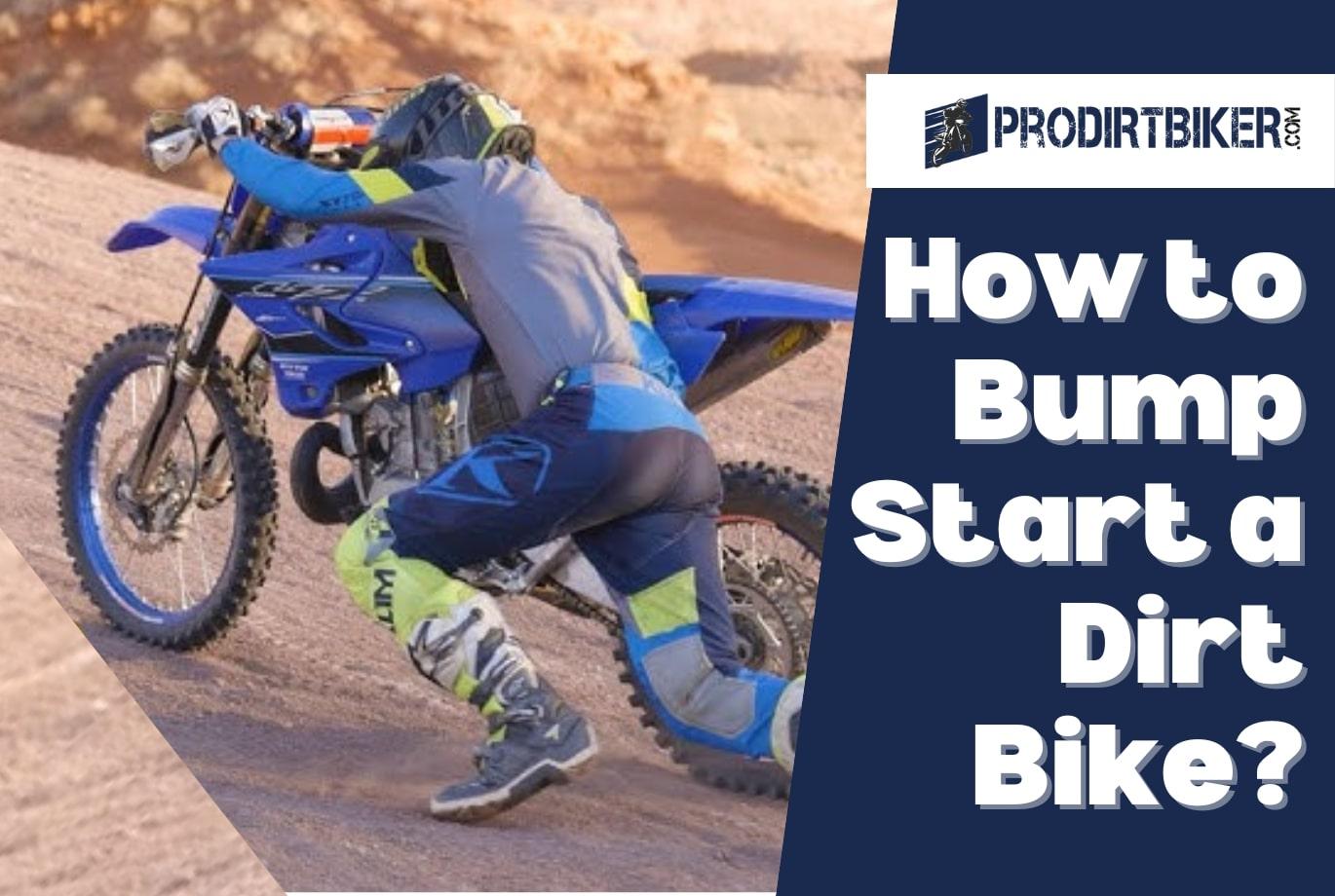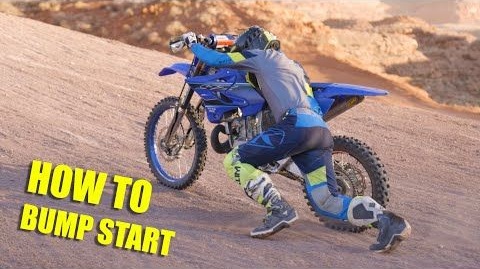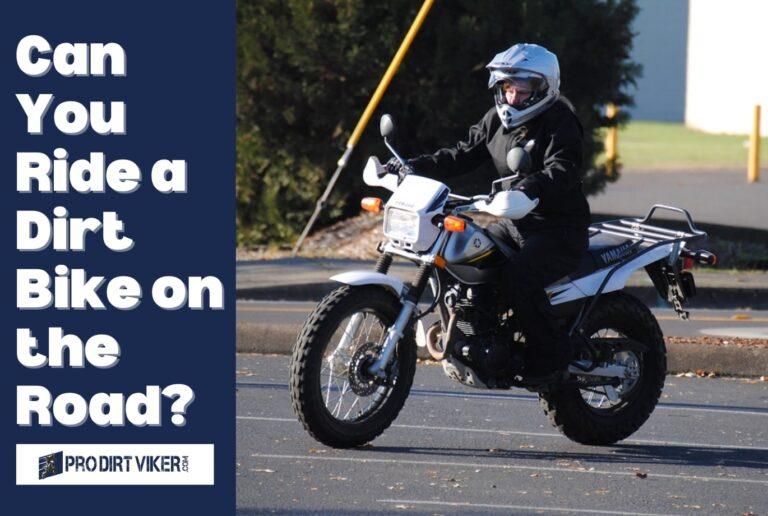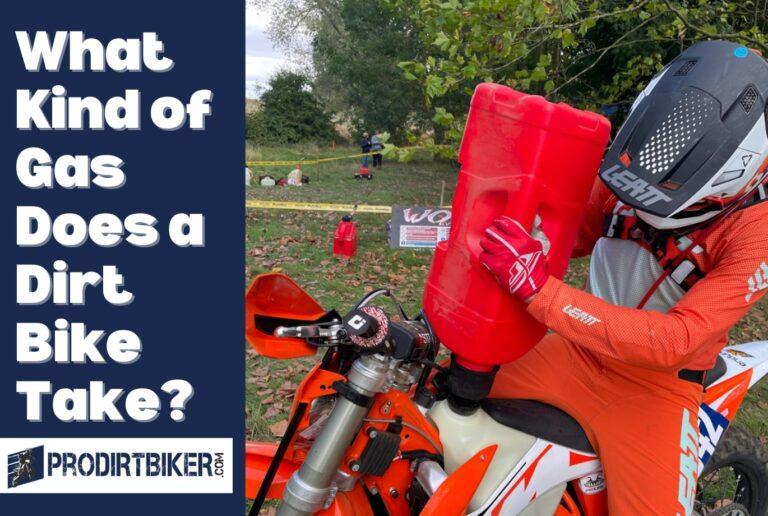How to Bump Start a Dirt Bike? Step-by-Step Guide

So, you’re out on the trails with your dirt bike, having a blast, when suddenly your engine dies. You try to kick-start it back to life, but nothing happens.
Don’t panic! In this blog post, we’ll show you how to bump start your dirt bike and get back on the ride in no time. Whether you’re a beginner or an experienced rider, these tips will have you bump starting like a pro. So grab your helmet and let’s dive in!
How to Bump Start a Dirt Bike?
To bump start a dirt bike, make sure the bike is in gear, push down on the kickstart, and quickly release it. The kickstart will engage the engine and start the bike.
Bump starting, also known as push starting or roll starting, is a method used to start a dirt bike when the electric starter or kickstarter is not working. Here’s a step-by-step guide on how to bump start a dirt bike:
1. Choose the Right Gear:
- Ensure the dirt bike is in second or third gear. These gears provide a good balance between speed and torque, making it easier to start the engine.
2. Find a Decline:
- Look for a slope or decline to help the bike gain momentum. You can push the dirt bike up the slope and then let it roll down.
3. Turn on the Ignition:
- Make sure the ignition is turned on, and the kill switch is in the “on” position.
4. Get the Bike Rolling:
- Push the dirt bike with some speed, either by running alongside it or having someone push you. You can also use a gentle downhill slope to assist in getting the bike rolling.
5. Pop the Clutch:
- Once you have sufficient speed, pull in the clutch lever and simultaneously release it quickly. This action engages the transmission and can turn over the engine.
6. Throttle Control:
- As you release the clutch, give a small amount of throttle to help the engine catch. Be careful not to give too much throttle, as this can cause the rear wheel to skid.
7. Repeat if Necessary:
- If the engine doesn’t start on the first attempt, repeat the process. Sometimes, it may take a couple of tries to get the timing right.
8. Gear Down:
- After the bike starts, shift to a lower gear to prevent the engine from stalling. You can then continue riding normally.
Keep in mind that bump starting may not work for all dirt bikes, especially those with automatic clutches or certain engine issues. Additionally, always prioritize safety and be cautious when bump starting, especially on uneven terrain. If you find yourself needing to bump start frequently, it’s advisable to have your bike inspected by a mechanic to address any underlying issues.
Understanding The Bump Start Technique
What Is A Bump Start And When Should You Use It?
Have you ever found yourself in a situation where your dirt bike refuses to start? It can be incredibly frustrating, especially when you’re in the middle of nowhere with no one around to help. This is where the bump start technique comes in handy.
A bump start, also known as a push start or roll start, is a method to start your dirt bike without the need for a working kick-start or electric starter. It involves using your body’s momentum to generate enough force for the engine to ignite.
Knowing when to use this technique can save you from being stranded in tricky situations. Here’s what you need to know:
- When you have a dead battery or a faulty electric starter, the bump start technique is a reliable way to get your dirt bike running again.
- It can be useful when you’re on a steep hill or uneven terrain where it’s difficult to engage the kick-start effectively.
- Bump starting also comes in handy when your bike’s engine floods, and the traditional starting methods don’t work.
- Additionally, this technique can be a lifesaver during races or off-road competitions when time is of the essence.

Before attempting a bump start, ensure you have the following:
- Safety Gear: Always wear appropriate safety gear, including a helmet, gloves, goggles, and protective riding gear. Safety should be your top priority.
- Terrain: Find a suitable location with a slight downhill slope or flat terrain. The slope will help build momentum.
- Bike in Neutral: Ensure your dirt bike is in neutral. This allows the rear wheel to spin freely when pushed.
- Check the Kill Switch: Make sure the kill switch is set to the “Run” position.
Step-by-Step Guide to Bump Starting a Dirt Bike
Follow these steps carefully to bump start your dirt bike:
- Position Your Bike: Place your dirt bike on the selected terrain, with the front wheel facing downhill if possible. Ensure it’s in neutral.
- Turn on the Ignition: Ensure your bike’s ignition switch is turned on.
- Set the Choke (if needed): If your bike has a choke, set it to the appropriate position for a cold start.
- Stand Beside Your Bike: Stand on the left side of your dirt bike, holding the handlebars with your left hand while steadying the bike with your right hand on the seat or subframe.
- Build Momentum: Push your bike forward, running alongside it to build up some speed. This may require some effort, so be prepared for a brisk jog or sprint.
- Release the Clutch: Once you’ve gained some speed (usually around 5-10 mph or 8-16 km/h), pull in the clutch lever completely. This disengages the clutch and allows the rear wheel to spin freely.
- Engage the Gear: While keeping the clutch lever pulled in, shift into second gear using the gear shift lever. Second gear is often recommended for bump starting.
- Release the Clutch: Quickly release the clutch lever. The engine should now engage, and if everything is in order, it will start running.
- Throttle Control: Be ready to control the throttle as soon as the engine starts. Give it a little gas to keep it running smoothly.
- Test the Brakes: As the engine starts, be prepared to use your brakes to slow down and regain control of your bike.
Common Bump Starting Issues
- Stalling: If your bike doesn’t start or stalls immediately after starting, you may need to repeat the process. Ensure you’ve built up enough momentum and that the bike is in neutral before attempting again.
- Clutch Control: Timing is crucial when releasing the clutch. It may take some practice to get it right without stalling.
- Battery Health: If you find yourself bump starting frequently, it might be a sign of a battery or electrical issue that needs attention.
The Mechanics Behind A Successful Bump Start
Understanding the mechanics of a bump start is crucial for its successful execution. Here’s how it works:
- Shift the bike into second or third gear, ensuring the kill switch is in the “on” position.
- Stand beside your dirt bike, gripping the handlebars firmly with both hands.
- Get a friend to push the bike or find a slight downhill slope where you can roll it.
- Once you gain enough speed, simultaneously release the clutch lever and push down with your body weight on the footpegs.
- The sudden release of the clutch engages the engine’s transmission, causing it to rotate rapidly.
- As the bike’s engine turns over, keep your weight forward, controlling the throttle and applying slight variations of throttle input to prevent stalling.
- Once the engine ignites, shift into a higher gear and continue riding.
Remember, practice makes perfect when it comes to the bump start technique. It may take a few attempts to get the timing and throttle control right, but with perseverance, you’ll master this skill in no time.
The Advantages Of Mastering This Technique
Mastering the bump start technique offers a range of advantages for dirt bike riders. Here are some benefits you can enjoy by becoming proficient in this skill:
- Quick and efficient starts: When your dirt bike fails to start using conventional methods, a bump start allows you to get back on your ride quickly and without hassle.
- Independence: By knowing how to bump start your bike, you no longer have to rely on external assistance or wait for help to arrive. This self-reliance can be a game-changer, especially when riding in remote areas.
- Competitive edge: In races or off-road competitions, where every second counts, being able to bump start your bike can save you valuable time and ensure you stay in the competition.
- Enhanced technical skills: Mastering the bump start technique requires fine-tuning your clutch control, throttle modulation, and balance. Developing these skills can improve your overall riding ability and make you a more confident rider.
Now that you understand the bump start technique, it’s time to put it into practice. Remember to prioritize safety while attempting the bump start and always wear appropriate gear. With patience and perseverance, you’ll be able to overcome any starting issues and keep your dirt bike running smoothly on every adventure.
Preparing For A Successful Bump Start
Bump starting a dirt bike can be a useful skill to have, especially if you find yourself in a situation where the electric starter isn’t working. But before you attempt a bump start, it’s important to make sure you’re properly prepared.
Ensuring your bike is in the correct gear and position, positioning yourself for maximum leverage, and properly gripping the handlebars and positioning your feet are all essential elements for a successful bump start.
Ensuring Your Bike Is In The Correct Gear And Position:
- Shift your bike into a gear that provides enough resistance to start the engine but isn’t too difficult to push.
- Make sure the bike is in neutral if it has one, or first gear if not.
- Ensure the ignition is on and the kill switch is in the “on” position.
Positioning Yourself For Maximum Leverage:
- Stand on the left side of the bike with your left foot on the footpeg and your right foot on the ground.
- Position yourself slightly forward, so your weight is centered over the bike.
- Keep your body relaxed but be ready to exert force when necessary.
Properly Gripping The Handlebars And Positioning Your Feet:
- Grasp the handlebars firmly, ensuring a secure grip.
- Position your left hand on the clutch lever and your right hand on the throttle grip.
- Keep your fingers on the front brake lever, ready to apply it if necessary.
- Place your feet firmly on the ground, with your toes pointing forward.
- Make sure you have a solid footing and can maintain your balance.
Remember, safety should always come first when attempting a bump start. If you don’t feel comfortable or if the bike doesn’t start after a few attempts, it’s best to seek professional help or address any underlying issues with your bike.
With the proper preparation and technique, bump starting a dirt bike can be a useful skill to have in your toolbox.
Executing The Bump Start Technique
Are you ready to kickstart your dirt bike without relying on a kickstarter? Look no further than the bump start technique. This handy skill allows you to get back on your dirt bike quickly when the kickstarter fails or when you find yourself on uneven terrain.
In this section, we will guide you through the process of executing the bump start technique, ensuring you are well-equipped to get your adrenaline pumping in no time. Read on to discover the key steps in this technique.
Finding A Suitable Obstacle For The Bump Start
To effectively execute the bump start technique, it’s vital to find a suitable obstacle that will assist you in generating the necessary momentum. Keep the following points in mind when selecting an obstacle:
- Look for a downhill slope or a slight incline that can provide the required downhill momentum.
- Ensure the obstacle is stable and free from any loose debris or obstacles that could cause accidents.
- Make sure there is enough space around the obstacle to comfortably maneuver your dirt bike.
Approaching The Obstacle With The Right Speed And Angle
Once you’ve identified a suitable obstacle, it’s crucial to approach it with the correct speed and angle to ensure a successful bump start. Consider the following:
- Gain some speed by pedaling or pushing your dirt bike before reaching the obstacle.
- Aim to approach the obstacle at a moderate speed, neither too fast nor too slow.
- Angle your bike towards the obstacle at around a 45-degree angle, ensuring you have a good line of sight beyond it.
Using Your Body Weight To Generate Momentum
As you reach the obstacle, it’s time to utilize your body weight to generate the necessary momentum for the bump start. Follow these steps:
- Stand on the bike’s footpegs while maintaining a relaxed grip on the handlebars.
- As you hit the obstacle, bend your knees slightly and prepare to shift your weight in a controlled manner.
- Once your front wheel hits the obstacle, shift your weight forward and push down on the footpegs to generate momentum.
By following these steps and practicing the bump start technique, you’ll be well-equipped to handle unexpected kickstarter failures or challenging terrains. Remember, mastering this skill requires practice, so take the time to perfect your technique and confidently hit the dirt trails with ease.
Overcoming Common Obstacles
Bump starting a dirt bike can be both exciting and challenging. Whether you’re dealing with steep inclines and challenging terrain, trying to get your bike started in muddy or sandy conditions, or recovering from a sudden stall mid-race, overcoming common obstacles is essential for any dirt bike enthusiast.
In this section, we will explore the strategies and techniques to tackle these obstacles head-on.
Dealing With Steep Inclines And Challenging Terrain:
- Stay focused and maintain a steady grip on the handlebars.
- Shift your body weight forward to maintain balance.
- Utilize the bike’s momentum by coming down the hill with some speed.
- Gradually release the clutch while simultaneously giving a bit of throttle.
- As the bike starts moving, adjust your position to accommodate the angle of the incline.
- Keep your feet on the foot pegs to maintain stability.
Bump Starting In Muddy Or Sandy Conditions:
- Clear away excess mud or sand from around the wheels and the chain.
- Find a solid surface or a higher ground to get better traction.
- Engage a higher gear to prevent the wheels from spinning excessively.
- Push the bike forward with your feet while simultaneously releasing the clutch.
- Once you feel the resistance, release the clutch fully and give a firm kick to the kickstart lever.
- As the bike starts, continue to apply gentle pressure on the throttle to keep it running.
Recovering From A Stall Mid-Race:
- Stay calm and quickly assess the situation.
- Shift down into a lower gear to easily engage the clutch.
- If possible, find a slight downhill or a flat area to help with the bump start.
- Push the bike forward to build up some momentum.
- Release the clutch abruptly while simultaneously kicking the kickstart lever.
- As the bike starts, re-engage the clutch and get back into the race seamlessly.
Remember, practice makes perfect when it comes to bump starting a dirt bike. By familiarizing yourself with these techniques and honing your skills, you’ll be able to overcome common obstacles and get back on track in no time. So, let’s hit the dirt and embrace the thrill of off-road biking!
Maintaining Momentum And Control
Techniques For Shifting Gears Smoothly During A Bump Start
When it comes to bump starting a dirt bike, shifting gears smoothly is crucial to maintain momentum and control. Here are some techniques to help you shift gears seamlessly during a bump start:
- Gradually release the clutch: As you accelerate and release the clutch lever, do it in a smooth and controlled manner to avoid abrupt shifts and sudden jerks.
- Timing is key: Coordinate your clutch release with the upward motion of the bike to ensure a seamless transition between gears.
- Use the throttle: Adjust the throttle as you release the clutch to match the engine rpm with the gear you’re shifting into, enabling a smoother gear engagement.
Tips For Maintaining Balance And Stability Throughout The Process
Maintaining balance and stability during a bump start is vital to ride smoothly and safely. Follow these tips to stay in control:
- Position your body correctly: Stand on the footpegs with your knees slightly bent, keeping your upper body relaxed and upright. This allows you to absorb any bumps or sudden movements without losing balance.
- Feather the rear brake: Gently apply pressure to the rear brake to stabilize the bike as you accelerate. This helps control the bike’s movement and prevents it from tipping over.
- Stay focused and alert: Keep your eyes up and scan the terrain ahead to anticipate any obstacles or changes in the riding surface. This helps you make quick adjustments and maintain stability throughout the bump start process.
How To Successfully Navigate Obstacles After A Successful Bump Start
After a successful bump start, you may encounter various obstacles on the trail. Here’s how to navigate them effectively:
- Maintain momentum: Once you’ve gained momentum, try to sustain it by properly shifting gears and smoothly accelerating. This allows you to conquer obstacles with ease.
- Choose the right line: Assess the obstacle ahead and select the best path to navigate through it. Look for the smoothest and least challenging route that keeps you in control of the bike.
- Shift your weight and use body positioning: Shift your body weight forward or backward depending on the specific obstacle. This helps maintain traction and balance during maneuvers like wheelies, jumps, or navigating rocky sections.
- Adapt and react: Stay flexible in your approach and adjust your riding technique as needed. Obstacles may require sudden changes in direction or speed, so be prepared to adapt quickly to maintain control and safely negotiate the challenges.
Remember, practice makes perfect. The more you bump start and ride, the better you’ll become at maintaining momentum, balance, and control. So get out there and embrace the exciting world of dirt biking!
Common Mistakes To Avoid
Bump Start A Dirt Bike
Over-gassing or under-gassing the throttle:
- Over-gassing the throttle can cause the rear wheel to spin out, resulting in a loss of control and potential accidents. It’s important to have a smooth and controlled throttle input to maintain traction and stability.
- On the other hand, under-gassing the throttle can make it difficult to get the engine started. A lack of sufficient power can cause the bike to stall or fail to start altogether. Finding the right balance and applying gradual throttle is key.
Incorrect positioning or weight distribution:
- Positioning your body and distributing weight correctly is crucial for a successful bump start. Failing to do so can hinder your balance and control over the bike.
- Make sure to position your body slightly forward, gripping the handlebars firmly, and keeping your weight centered. This will help maintain stability and prevent the bike from tipping over during the bump start.
Failing to anticipate and react to changing terrain:
- Riding off-road means facing various terrains, from loose dirt to uneven surfaces. Ignoring or failing to react to these changes can lead to accidents and a failed bump start.
- Stay alert and anticipate any obstacles or bumps in the terrain. This way, you can adjust your body position and throttle input accordingly, ensuring a smoother and successful bump start.
Remember, mastering the bump start technique requires practice and proper technique execution. By avoiding these common mistakes and focusing on your technique, you’ll increase your chances of successfully bump starting your dirt bike and enjoying your off-road adventures to the fullest.
Practicing And Improving Your Bump Start Skills
Bump starting a dirt bike can be a challenging task, especially for beginners. However, with practice and dedication, you can become proficient in this essential skill. In this section, we will explore some effective strategies for practicing and improving your bump start skills.
Whether you’re a novice or an experienced rider looking to enhance your technique, these tips will help you become a master of the bump start.
Creating A Controlled Practice Environment:
- Find a safe and open area where you can practice without any obstacles or distractions.
- Ensure that the terrain is suitable for dirt bike riding, with enough space to maneuver comfortably.
- Remove any loose debris or objects that could interfere with your practice session.
- Consider wearing protective gear, such as a helmet and knee pads, to minimize the risk of injury.
Setting Goals And Tracking Progress:
- Clearly define your objectives for each practice session. For example, you may want to focus on improving your clutch control or refining your timing.
- Break down your goals into smaller, achievable targets. This will allow you to track your progress and stay motivated.
- Keep a record of your practice sessions, noting any improvements or areas that require further attention.
- Celebrate milestones along the way, as this will help boost your confidence and reinforce your commitment to mastering the bump start.
Seeking Guidance From Experienced Riders:
- Reach out to experienced dirt bike riders who can offer valuable insights and guidance.
- Attend dirt bike training courses or workshops to learn from professionals.
- Observe experienced riders in action and take note of their techniques and strategies.
- Ask for feedback and tips from riders who have mastered the bump start skill.
By creating a controlled practice environment, setting clear goals, and seeking guidance from experienced riders, you can effectively practice and improve your bump start skills. Remember, practice makes perfect, so don’t get discouraged if it takes time to master this technique.
With patience, determination, and the right approach, you’ll soon be bump starting your dirt bike with confidence and ease. So, get out there, hit the dirt, and start practicing!
Frequently Asked Questions On Bump Start A Dirt Bike
How Do You Bump Start A Dirt Bike?
To bump start a dirt bike, push the bike to a comfortable running start and quickly shift into second gear while releasing the clutch.
Can You Bump Start A Dirt Bike With A Dead Battery?
Yes, you can bump start a dirt bike with a dead battery by following the standard bump start procedure.
What Can Cause A Dirt Bike To Not Start?
A dirt bike may fail to start due to various reasons such as a dead battery, faulty spark plug, fuel issues, or a malfunctioning ignition switch.
Is Bump Starting Bad For A Dirt Bike?
Bump starting is generally safe for a dirt bike if done correctly. However, repetitive bump starting may cause damage to the transmission.
Can You Bump Start A Two-Stroke Dirt Bike?
Yes, two-stroke dirt bikes can be bump started using the same technique as four-stroke bikes.
Conclusion
To sum up, mastering the skill of bump starting a dirt bike is essential for any rider. It offers a reliable backup option when the electric start fails, ensuring you can quickly get back in the race or continue your adventure.
By following the steps mentioned in this blog post, including finding the right slope, using proper gear, and maintaining proper body posture, you can successfully bump start your dirt bike without any hassle. Remember to take safety precautions and practice in a controlled environment before attempting it on challenging terrains.
Regular maintenance and proper care of your dirt bike’s battery and electrical system can also minimize the chances of encountering a start-up issue. So, gear up, gain confidence, and embrace the thrill of bump starting your dirt bike like a pro! Happy riding!






